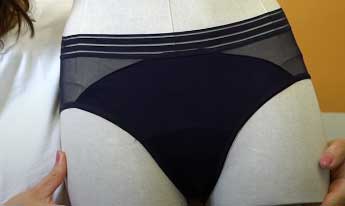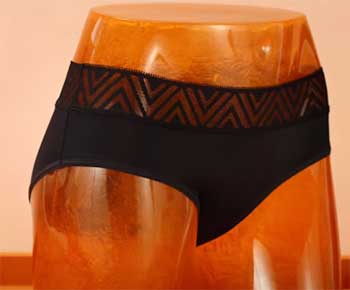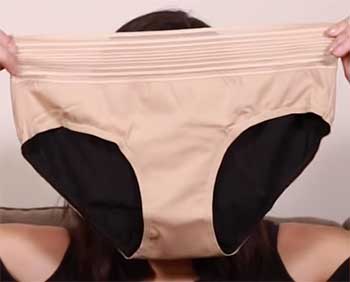Menstrual underwear, also known as period panties or leakproof underwear, has surged in popularity in recent years as an eco-friendly and comfortable alternative to disposable pads and tampons. Two major players in this space are Saalt and Thinx.
But how exactly do these two brands of reusable period underwear stack up?
Key Differences At A Glance
| Saalt | Thinx |
| Founded in 2018 | Founded in 2013 |
| Based in the USA | Based in the USA |
| 2 main underwear styles | Multiple style options |
| Organic cotton gusset | Various fabrics including cotton, nylon, and spandex |
| Leakproof performance rated light, medium, heavy flow | Absorbency levels 1-5 |
| Machine washable | Machine washable |
| 1 year warranty | No warranty stated |
As you can see from the table, while Saalt and Thinx share some core functionality as reusable underwear designed to replace disposable period products, there are also some notable differences between the two brands.
Thinx offers more style varieties while Saalt currently has just two main underwear cuts. Saalt uses organic cotton specifically in the gusset while Thinx utilizes a mix of fabrics.
The brands also rate their leakproof performance a bit differently, with Saalt denoting light, medium and heavy coverage and Thinx denoting numerically from levels 1 to 5. Only Saalt offers a 1 year warranty on their underwear, whereas no warranty duration is specified by Thinx.
Now let’s dive deeper into the specifics around materials, absorbency, sizing, costs, and more.
Comparison of Fabrics and Feel
The composition of the fabrics used can make a significant difference in the comfort, breathability, and performance of period panties.

Saalt constructs the gusset (i.e. the part that sits against your body) of their underwear from GOTS certified organic cotton, with a waterproof lining designed for leak protection.
The rest of the panty is made from a mix of nylon and spandex.
Many users praise Saalt for feeling soft and breezy while providing leak protection you can count on.
Thinx offers more style varieties, ranging from thongs to bike shorts to panties, constructed from a mix of moisture-wicking fabrics like cotton, nylon, spandex and TENCELTM Lyocell.
While composition varies by style, Thinx aims to strike the right balance between comfort, protection, sustainability and chic aesthetics. Some buyers have noted the styles with more synthetic fabrics can feel less breathable.
So while Saalt sticks to its simple organic cotton gusset for all styles, Thinx tailors the fabric blends to each product’s intended use case.
Comparison of Absorbency Levels
A key factor in choosing reusable period underwear is making sure it offers adequate leak and stain protection for your unique flow. Here’s how Saalt and Thinx allow you to customize absorbency:
The Saalt underwear line includes Wear, Active and Heavy Duty styles. Saalt Wear works best for light flow days or as a backup to tampons and cups. Saalt Active steps up the protection for medium flow days. Finally, Saalt Heavy Duty maximizes absorbency for your heaviest days.
Thinx takes a different approach with assigning absorbency ratings from 1 to 5:

- Level 1: ultrathin protection for light days
- Level 2: equivalent to a regular tampon
- Level 3: approaching a super tampon’s capacity
- Level 4: matches super tampon absorbency
- Level 5: ultra-absorbent for very heavy flow
So in summary, Saalt allows you to select for light, medium or heavy flow in one seamless style of underwear available in two cuts.
Thinx requires you to choose the specific style based on your typical flow, with more panty options tailored to light (level 1-2), medium (level 3) and heavy (level 4-5) coverage needs.
Sizing and Fit Comparison
Finding the right size is crucial for comfort and leak protection when it comes to period panties. Here is how Saalt and Thinx compare:
Saalt – Sizes range from XS to 3XL. To determine your size, Saalt provides a printable fitting chart that accounts for both your waist and hip measurement. Reviewers praise the chart’s accuracy and find Saalt’s sizing to be very consistent and true-to-fit.
Thinx – Sizes available from XS to 4X, with select styles going up to 6X. Thinx provides an interactive quiz on their site to identify your suggested size based on height, weight and average pant size.
However, some buyers report issues with the quiz recommendations and prefer to reference the size charts for each style. Thinx sizing and fit seems to vary more between styles compared to Saalt.
For the best fit, both Saalt and Thinx recommend taking your own measurements and cross-referencing the size guides rather than strictly relying on your typical off-the-rack pant size. Saalt’s more standardized sizing methodology makes it a bit easier to select your size confidently.
Also Read: Is Everdries Leakproof Underwear Worth It?
Cost Comparison
Upfront investment is typically higher for reusable period underwear compared to disposables. But over time, the savings from not having to buy pads and tampons add up. Here’s how Saalt and Thinx pricing shakes out:
Saalt period underwear ranges from $24 to $32 per pair depending on the absorbency level.
Thinx period underwear ranges from $24 to $42 per pair depending on the style and absorbency rating.
On the surface, the per-pair pricing is very similar between the brands. However, Saalt offers sale promotions more frequently than Thinx – so the potential savings may balance out in Saalt’s favor with strategically timed purchases.
Both brands offer subscription programs that can help take some of the bite out of the initial investment by allowing you to pay over time. Saalt’s bundles also temporarily drop the per-pair pricing, although Thinx’ subscription pricing doesn’t appear discounted.
Additional Factors To Consider
Beyond cost, sizing, fabrics and absorbency – here are a few other factors that may sway your decision between Saalt and Thinx:

- Brand ethos – Both labels aim to shake up the period industry and fill gaps in innovation left by legacy companies. Saalt bills itself as “by women, for women” while Thinx touts its “by women, for all bodies” mantra.
- Style selection – If you like having lots of cuts, colors and prints to choose from, Thinx is undoubtedly the winner here with over a dozen panty styles catering to different activities. Saalt’s selection is much more limited, but the focus on perfecting those two styles shows in the fine details.
- Customer service – Both brands offer direct support channels and responsive teams. However Saalt goes a step further with quicker fulfillment and returns processing under their 1 year warranty program. So if you want that extra peace of mind, Saalt has the edge.
- Eco credentials – Thinx heavily promotes sustainability initiatives around water savings, solar power, responsible packaging and circularity efforts like recycling programs. Saalt holds GOTS organic certification and uses Bluesign approved textiles, but has fewer quantified impacts to report at this stage.
Also Read: Is Unders By Proof Better Than Thinx Period Underwear?
Frequently Asked Questions (FAQ)
There is no medical reason you would need to stop wearing Thinx underwear specifically. As with any underwear, you should cease use if you experience any persistent irritation, discomfort, or reactions you suspect may be linked to the materials. Some wearers may prefer to avoid Thinx styles with higher spandex content during infections or inflammation. But in general Thinx are dermatologically tested to be safe, breathable and gentle for regular use.
Some Thinx underwear styles do claim to provide leak protection against light bladder leaks, like the Spearhead thong and Stealth brief. The layer technology helps contain small accidents. However they are not intended to fully replace adult incontinence products for severe or consistent loss of bladder control.
For absorbency against light bladder leaks specifically, Knix may have an edge over Thinx. More Knix underwear styles are designed with features like rapid-dry layers and extended leak barriers to provide insurance against dribbles. However Thinx does offer leak protection for bladder leaks in select styles as well. Ultimately it comes down to your personal flow experience and preferences around style, cost and sizing.
In July 2022, Knix was hit with a class action lawsuit alleging their leakproof claims to be “false and deceptive”. The lawsuit argues Knix advertising sets unrealistic expectations around the underwear’s ability to fully contain leaks. To date none of the allegations have been legally proven or settled in court. But the controversy does highlight the importance of brands being clear about product limitations – and matching your absorbency needs to the best style and flow rating for your biology.
Also Read: Comparison of Thinx And Period Company Underwear.
The Bottom Line
At the end of the day, Saalt and Thinx both make well-performing period underwear that can feasibly replace disposables – and potentially save you big bucks over time on top of keeping waste out of landfills.
Saalt bras itself as the menstrual underwear to turn to when you want no-fuss, comfort-focused protection you can trust. The streamlined size chart takes the guesswork out of finding your fit, and the organic cotton gusset aims to deliver that “second skin” sensation.
Not to mention perks like fast processing and the 1 year warranty provide that extra confidence to take the leap into reusables.
If you know your general flow level and want to explore a wider diversity of colors, cuts and fabrics first, Thinx fills that niche. The absorbency rating methodology gives you flexibility to align protection with your cycle’s fickle changes. And the rich style selection lets you shift between thongs for your gym leggings all the way up to bike shorts for heavy overnights.
At the end of the day, you can’t go wrong investing in either brand. As leaders in reversing period stigmas and pioneering innovation in the menstrual space, Saalt and Thinx both enable you to wear your values proudly while keeping waste at bay.
Once you make the switch to reusables, you may find yourself wondering why you waited so long!



